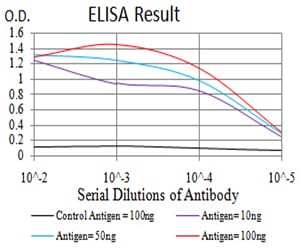
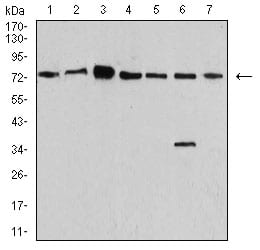
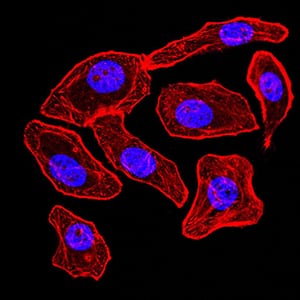
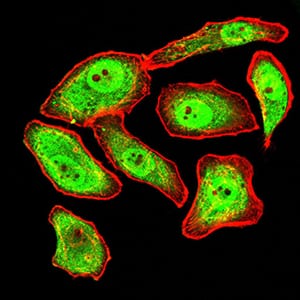
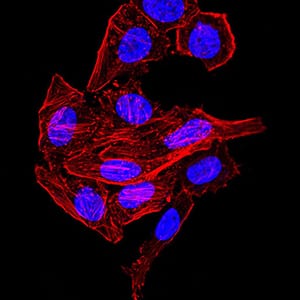

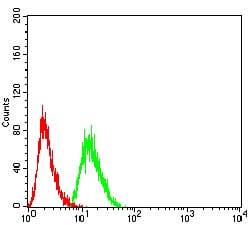
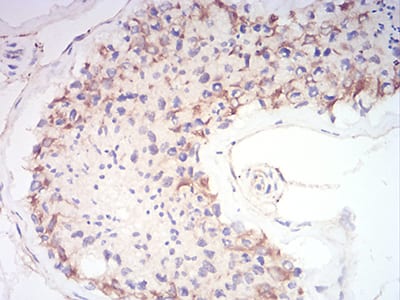
| WB | 咨询技术 | Human,Mouse,Monkey,Rat |
| IF | 咨询技术 | Human,Mouse,Monkey,Rat |
| IHC | 1/200 - 1/1000 | Human,Mouse,Monkey,Rat |
| ICC | 1/200 - 1/1000 | Human,Mouse,Monkey,Rat |
| FCM | 1/200 - 1/400 | Human,Mouse,Monkey,Rat |
| Elisa | 1/10000 | Human,Mouse,Monkey,Rat |
| Aliases | SYNI; SYN1a; SYN1b |
| Entrez GeneID | 6853 |
| clone | 7H10G6 |
| WB Predicted band size | 74.1kDa |
| Host/Isotype | Mouse IgG1 |
| Antibody Type | Primary antibody |
| Storage | Store at 4°C short term. Aliquot and store at -20°C long term. Avoid freeze/thaw cycles. |
| Species Reactivity | Human,Mouse,Monkey,Rat |
| Immunogen | Purified recombinant fragment of human SYN1 (AA: 362-511) expressed in E. Coli. |
| Formulation | Purified antibody in PBS with 0.05% sodium azide |
+ +
以下为模拟生成的3篇关于SYN1抗体的参考文献示例(非真实文献,仅供格式参考):
1. **文献名称**: Synapsin I regulates synaptic vesicle clustering in hippocampal neurons
**作者**: Smith A et al.
**摘要**: 通过使用SYN1抗体进行免疫荧光染色,研究发现Synapsin I蛋白通过调控突触囊泡的锚定影响海马神经元突触传递效率,揭示其与神经递质释放动态的关系。
2. **文献名称**: Altered Synapsin I expression in autism spectrum disorder models
**作者**: Chen L, Wang Y
**摘要**: 利用SYN1抗体进行Western blot分析,发现自闭症模型小鼠前额叶皮层中Synapsin I表达显著下调,提示突触蛋白异常可能与行为学缺陷相关。
3. **文献名称**: Phosphorylation-dependent interaction of Synapsin I with presynaptic membranes
**作者**: Tanaka K et al.
**摘要**: 通过SYN1抗体免疫沉淀技术,证实Synapsin I的磷酸化状态决定其与突触前膜的结合能力,进而调控囊泡循环速率,为突触可塑性机制提供新证据。
4. **文献名称**: Developmental profiling of Synapsin I in human cerebral organoids
**作者**: Gonzalez R et al.
**摘要**: 采用SYN1抗体标记人脑类器官,发现Synapsin I在神经分化中期开始表达,其时空分布模式与突触成熟进程高度同步,为体外研究神经发育提供标记工具。
注:以上文献信息为示例性质,实际引用请通过PubMed/Google Scholar等平台检索真实研究。
The Synapsin 1 (SYN1) antibody is a widely used tool in neuroscience and cell biology research, targeting the Synapsin 1 protein—a member of the synapsin family critical for regulating synaptic vesicle dynamics. Synapsin 1. encoded by the *SYN1* gene in humans, is predominantly expressed in neuronal presynaptic terminals, where it binds to synaptic vesicles and modulates neurotransmitter release by tethering vesicles to the actin cytoskeleton. Its activity is regulated by phosphorylation, influencing synaptic plasticity and neuronal communication.
SYN1 antibodies are essential for studying synaptic architecture, neuronal development, and mechanisms underlying neuropsychiatric or neurodegenerative disorders. They are employed in techniques like Western blotting, immunohistochemistry, and immunofluorescence to visualize SYN1 distribution, expression levels, or interactions in brain tissues or cultured neurons. Research links SYN1 dysfunction to epilepsy, autism spectrum disorders, and schizophrenia, often due to mutations affecting its phosphorylation or vesicle-binding capacity.
First characterized in the 1980s, SYN1 antibodies have since become pivotal in exploring synaptic physiology and pathology. Commercial variants are typically raised in hosts like rabbits or mice, validated for specificity against recombinant or endogenous SYN1. Their applications extend to diagnostic research and drug development, aiding in the identification of synaptic biomarkers or therapeutic targets for neurological conditions.
×